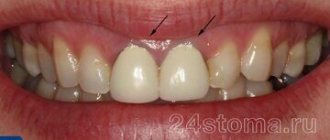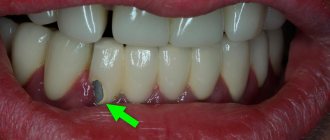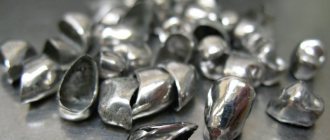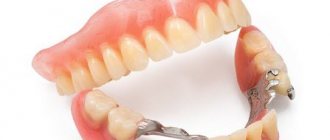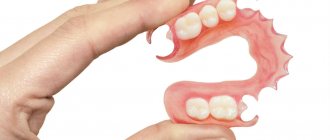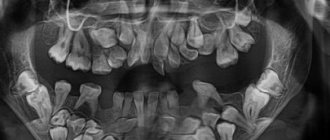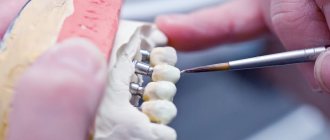10536
A crown is a single permanent prosthesis that acts as a kind of cap on a damaged tooth, and can serve its owner for 15 years, subject to the installation regulations and rules of care during use.
However, if an unpleasant odor or painful sensations appear, it becomes necessary to dismantle the structure.
Removing a crown from a tooth is an unpleasant procedure, but in some cases it is the only way to eliminate the problem.
Indications
Prosthetics with crowns is a labor-intensive and time-consuming procedure, sometimes accompanied by pain and discomfort.
To remove the structure, the specialist must have compelling reasons, otherwise he will do everything possible to avoid extreme measures.
A fixed orthopedic device is subject to disposal in the following cases:
- Incorrect installation of the product .
The crown may lose stability due to mistakes made by the doctor during its installation, the use of low-quality dental cement, or the destruction of the filling connecting material at the junction points. It is easy to recognize such a problem, since the dental unit begins to loosen and cause discomfort during eating and conversation. - Formation of a cyst on a tooth under a denture . This pathology rarely occurs as a result of various provocateurs. After removing the structure, the specialist removes the abnormal cavity and carries out full treatment.
- Destruction of an adjacent tooth . Another indication for re-prosthetics. In such a situation, the doctor advises installing a bridge instead of two adjacent prostheses.
- Bad odor and toothache. In this case, there is an urgent need for treatment hidden under the structure of the teeth.
Signs of the inflammatory process can develop against the background of the action of infectious agents, progression of pulpitis or secondary caries. In less severe situations, the doctor does not remove the prosthesis, but drills a small hole in it through which he carries out therapeutic treatment.After all the necessary manipulations have been carried out, the hole is filled with cement. Such work significantly reduces the service life of the structure.
- Inflammatory processes in the periodental tissues and gum disease .
Disease processes in periodontal tissues can develop due to various factors - inflammation, trauma, poor-quality manufacturing and fixation of the product. The structure puts strong pressure on the free gum, rubs, and a serious pathology begins to develop that cannot be treated independently. The product must be removed with subsequent treatment of soft structures. - Repeated prosthetics at the request of the patient . The patient can independently decide to replace the device with a more expensive and high-quality product.
- Broken prosthesis . The appearance of cracks and chips on the surface of the crown is also a reason for its dismantling.
Features of the production of Noritake metal-ceramic crowns, their advantages and disadvantages.
Come here if you are interested in the characteristics of Duceram metal-ceramic crowns.
At this address https://www.vash-dentist.ru/protezirovanie/nesemnyie-p/koronki-np/metallokeramicheskih-vita.html there is a detailed description of the Vita crown.
When is crown removal necessary?
- Removing the crown from a tooth must be done if the tooth begins to emit an unpleasant odor or hurt. The reason for this may be an inflammatory process that has begun to develop under the prosthesis.
- The second indication for removal and replacement is loosening of the crown. The main reason for this is the resolution of the cement material on which the crown was fixed. This can happen if the dentist chose the material poorly or made a number of mistakes when installing the prosthesis.
- Over time, the crown may need to be replaced. Once every 10 years, you should visit an orthopedist to check how the crown is worn.
- Also, the crown should be replaced if gum inflammation occurs, an injury has occurred, and the patient is awaiting orthodontic treatment.
Techniques
In dental practice, various methods of removing crowns are used. The choice depends on the existing clinical picture and the target direction of dismantling.
The decision on the method used is made by the patient, taking into account his financial capabilities and the time he can devote to it. Let's consider the existing options in detail.
Kopp apparatus
A crown remover is a dental instrument that greatly simplifies the work of a specialist and gives him the opportunity to painlessly remove the prosthesis without resorting to its destruction.
The device looks like a special hook , the operation of which is started by a button located on the holder. The procedure begins with breaking the cement under the structure using a drill. Next, using special forceps and hooks, the crown is picked up and picked out.
The method is considered a low-traumatic and painless procedure. However, it has one significant drawback - in some cases the device leaves scratches on the ceramic coating of the product , as a result it will require restoration.
Coronaflex device
The device operates on the basis of compressed air , which destroys cement. At the beginning of the procedure, the device should be operated with minimal impact force to avoid damage to the tooth.
The crown in the chewing area is removed using forceps. The device is installed so that its body is under the arc of the forceps.
special brackets as auxiliary tools , which are fixed on the crown using an adhesive system. Then the procedure continues according to the principle of the previous method with forceps.
When using the Coronaflex device, there is practically no risk of damage to a fixed prosthesis , but the price of the instrumentation is quite high, which affects the cost of removing the structure.
For this reason, the use of the device is justified in a situation when it becomes necessary to dismantle an expensive crown, for example, made of zirconium dioxide.
What are porcelain dental crowns and how practical are they?
In this publication you will find detailed information about steel crowns.
Here https://www.vash-dentist.ru/protezirovanie/nesemnyie-p/koronki-np/bolit-zub-pod-chto-delat.html we will answer the question: why does the tooth under the crown hurt when pressed.
Sawing
After using this method, repeated prosthetics with the same design is impossible.
Many patients mistakenly believe the procedure is painful, but in fact their fear is in no way justified. During sawing, the patient does not even experience any discomfort.
As a rule, this method is used in the case of inexpensive products that are subject to liquidation. Usually we are talking about metal ceramics.
However, specialists often resort to cutting to remove ceramic crowns, which requires the use of a diamond bur and special tools .
Ultrasound
Under the influence of a sound wave, cement loses its stability. But this method is not applicable to every material.
If we are talking about glass ionomer cement (a material based on polyacrylic acid and aluminofluorosilicate glass powder), its use is devoid of expediency and practical benefit.
Thanks to this method, the doctor can preserve the model and its shape without damage.
The video shows the process of removing the crown.
About pain and self-liquidation
The level of complexity and pain of each of the listed methods depends on the experience and professionalism of the doctor.
If the removal of the structure involves the destruction of the cement base, the crown easily falls out, such manipulation is easy and painless.
If a fixed prosthesis is installed firmly and stably, and dismantling requires maintaining the integrity of the product, the duration of the procedure increases, which causes discomfort in the patient. In such cases, the use of anesthesia is appropriate .
If there is severe pain under the structure, a person looks for forced ways to eliminate the product at home. Lack of experience and special equipment are considered to be the cause of adverse consequences.
Any attempts to independently remove the prosthesis lead to its damage or injury to the soft tissues of the oral cavity.
For this reason, such manipulations are carried out in a clinical setting. A qualified doctor with special equipment will perform correct crown removal.
You can remove the orthopedic device yourself in two cases:
- the product has become loose or has come off together with the cement base;
- the structure fell apart and it became necessary to extract the remaining fragments.
To avoid further complications, a person should seek help from a specialist as soon as possible.
Price
The complexity of the process and its cost will largely depend on the material of the permanent structure and the type of device with which it will be removed.
Let's look at the average cost of techniques using the table as an example.
| Technique | Price in rubles for one prosthesis |
| Kopp apparatus | 1 000 |
| Coronaflex device | 1 500—1 800 |
| Sawing | 800 |
| Ultrasound | 900 |
Most dental clinics include in the cost of dismantling fixed structures the price for further treatment and re-prosthetics.
Stock
-9%
BASAL COMPLEX - Restoration of teeth on 1 jaw in 3 days 330,000 rub.
300,000 rub.
get -20 %
Manufacturing of removable denture Acry Free 40,000 rub.
32,000 rub.
get -47 %
Dental implantation RUB 18,500.
until 01/15/2022 35,000 rub. 18500 rub.
get -35 %
Metal-ceramic crown 10,000 rub.
6500 rub. get
Following actions
After removal of the orthopedic product, the patient may experience discomfort and pain.
To identify the cause of pain, a specialist examines the condition of the tooth. In some cases, radiography is performed for an accurate diagnosis.
The doctor’s algorithm for further actions will depend on the situation as a result of which the crown had to be removed:
- Treatment of the inflammatory process. In the presence of diseases such as pulpitis, caries and periodontitis, the root canals of the tooth are unfilled.
Next, the doctor’s task is to prevent the pathological process in tissues using anti-inflammatory therapy. At the last stage of treatment, a filling is installed. - Restoration. To prevent subsequent destruction of the crown if it is damaged or chipped, restoration measures are required.
- Replacement of cement when it is destroyed . Here it is important to quickly treat the stump with antiseptic agents and re-fix the prosthesis using new dental cement.
- Replacement of the structure at the request of the patient or if it is impossible to reuse it .
Using an x-ray, the doctor evaluates the quality of filling the dental canals, as well as the condition of the periodontal structures. After this, you can select and order a new design.
The therapeutic course of treatment includes the following procedures:
- to fight infection and eliminate inflammation, the patient is prescribed medications from the group of antibiotics;
- Rinsing the mouth with decoctions of medicinal herbs and Furacilin solution is effective;
- To reduce pain, dentists recommend using anti-inflammatory compresses with an analgesic effect.
A paste made from 1 tablet of Nurofen and a few drops of boiled water has worked well here. It is rubbed into the wound area.
In rare cases, the tissue under the crown becomes permanently damaged and cannot be saved. Under such circumstances, the doctor warns the patient about the extraction of the tooth from the alveolus and the impossibility of re-fixing the crown.
As an alternative, you can choose another prosthetic option or resort to implantation.
Treatment
Any type of crown has its own service life, so it is necessary to look at the problem sensibly when pain under a structure made of metal by stamping occurs after 13-17 years of regular wear.
This means that you should not place your hopes on the fact that over all these years the tooth under the microprosthesis has remained healthy and will not bother its owner.
The situation changes if the tooth under the structure “alarms” immediately after prosthetics
It is important to recognize the true cause of what is happening here.
Identifying the problem on your own is quite problematic, so you should completely rely on the integrity and professionalism of your dentist. He will conduct a consultation, prescribe pictures of the jaw and identify the provocateur of painful sensations.
An experienced dentist will find the causative factors of pain and draw up a treatment plan for the unit. In an extremely critical situation, the damaged bone organ is removed, and a secondary prosthetic plan is drawn up according to a new scheme using updated data.
The most optimal method of therapy before treatment and preventive measures to improve the health of the oral cavity involves removing the crown. However, it is unwise to reinstall the same structure, since when removed it is subject to irreversible deformation.
Today, doctors everywhere use a number of methods to relieve the patient of pain under the dental structure without removing it.
Treatment of a living tooth
In such a situation, the pain syndrome is acute. The unit reacts painfully to hot and cold exposure. This indicates the presence of a carious lesion.
The specialist drills a hole in the structure and removes damaged tissue. An artificial hole is made on the chewing side of the tooth, and after treatment it is filled with filling material.
Treatment of a tooth without a nerve
If the unit was previously depulped, the patient will experience aching pain accompanied by pulsation in the temporal region and ear.
This condition is diagnosed as chronic periodontitis (long-term inflammation of periodontal tissues due to infection). Treatment methods are determined depending on the presence or absence of a pin in the root canal:
- The canal is closed only with a filling.
The doctor opens the crown, removes the filling material from the canal and cleans it. Next, the tooth cavity is filled with the drug. This procedure usually requires several visits to the doctor. As soon as the signs of inflammation completely disappear, the dental unit is filled. - A pin is installed in the channel.
Under such circumstances, treatment of periodontitis is carried out using apicoectomy (surgery to remove the apex of the root). This is the only effective technique in this case, which involves amputation of the affected area of the root with subsequent blocking of the infectious process. A simple surgical procedure is performed through an incision in the gum tissue.
Inflammation of the gums around the denture
This painful manifestation is often caused by deformation of the microprosthesis or its incorrect installation.
In such cases, a specialist will temporarily eliminate the symptoms. After some time, the pain returns again, so the denture will have to be removed and the tooth may need to be removed.
Is it possible to install ceramic crowns on chewing teeth, and what is the service life of the products?
In this article we will tell you when it is indicated to install an inlay in a tooth under a crown.
Here https://www.vash-dentist.ru/protezirovanie/nesemnyie-p/viniryi-np/kompozitnyie-foto-do-i-posle-ih-ustanovki-plyusyi-tsenyi.html we offer detailed information about dental restoration with composite veneers .
Reviews
Dental prosthetics is not the cheapest service provided by dental clinics. Therefore, before the procedure, it would be useful to approach the search for an experienced doctor with special care.
This will help avoid unforeseen situations when, due to mistakes made during installation, re-prosthetics cannot be avoided.
If after reading the article you would like to share your own opinion on this topic, leave your comment below.
If you find an error, please select a piece of text and press Ctrl+Enter.
Tags: dental crowns, fixed dentures, removal of a crown from a tooth
Did you like the article? stay tuned
Previous article
The essence of using individual zirconium abutments
Next article
The use of an angular abutment to achieve high aesthetic prosthetics
